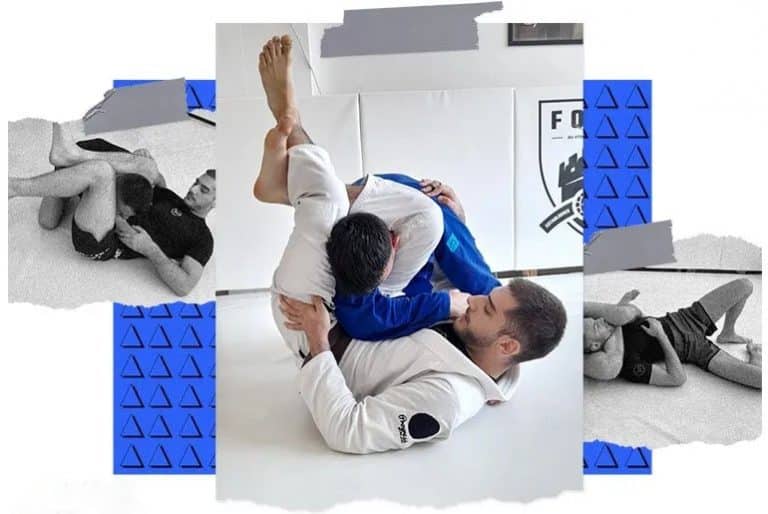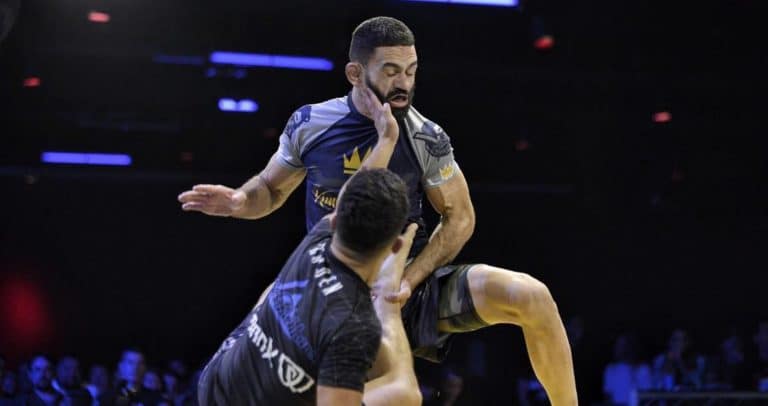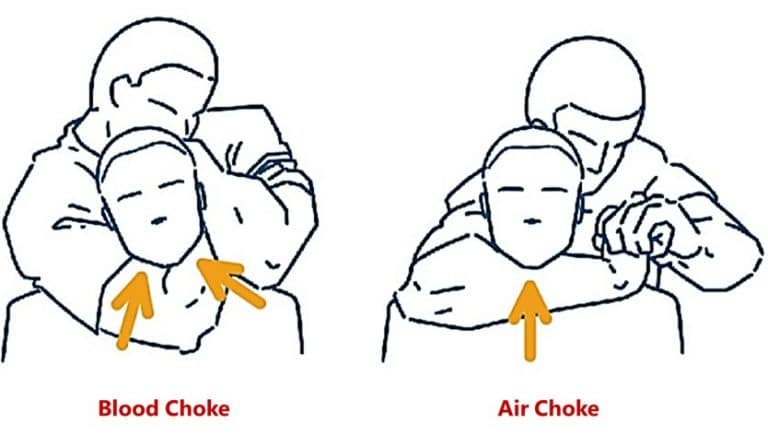Best Stretches for Brazilian Jiu-Jitsu to Improve Flexibility and Prevent Injury

Do you feel tight, beat up, and unable to perform some positions in BJJ simply because you’ve been led to believe that you’re not flexible? You’ve probably skimmed through the internet for a good stretching routine but found nothing noteworthy? To be frank, there’s a lot of workouts and stretches for BJJ out there. That’s why we’ve gathered for you the essential jiu-jitsu stretches every BJJ athlete should know. The goal is to keep it simple, short, and effective.
Brazilian Jiu-Jitsu is pretty demanding on your body. And If you’re reading this, you have most likely spent enough hours on the mat to develop tightness or maybe you already have movement restrictions.
The reality is that BJJ capitalizes on very extreme submissions that go against human movement mechanics. That’s you need not just any kind of flexibility, you need Jiu-Jitsu flexibility. According to a study done by Andreato L. et al. on the physiological profiles of BJJ athletes, a high level of flexibility for BJJ can help with technique performance. This will indirectly help you learn more techniques with ease, and make you improve faster.
Rest assured, we got you covered. The following BJJ stretches are selected to improve flexibility in the muscles and joints involved with the sport. Before jumping into it, be aware that there are two types of flexibility:
- Static flexibility is based on the joint’s mobility without accelerating the movement.
- Dynamic flexibility requires full joint mobility and includes speed.
The following stretches will be targeting static flexibility, so it’s best done at the end of practice. Since stretching before training BJJ or any physical activity for that matter might reduce power output and strength.
To compliment your cool-down with dynamic flexibility, you can check out the limber 11 routine.
The Importance of Flexibility in BJJ

Flexibility is crucial in BJJ. Take it from John Danaher, the mastermind behind the leg lock systems: he insisted that those who had better control of their legs better will progress faster in BJJ. A lot of positions involve the legs, and a lot of submissions are interconnected by transitions using the legs.
Of course, Jiu-jitsu isn’t just about flexibility, but it’s still a sport, therefore BJJ practitioners should train like athletes. Power, speed, agility, and flexibility are all underlying components that can elevate your game, so do not neglect them!
If you still wonder about how important stretching is, here’s some food for thought on flexibility by Eddie Bravo.
Oh, and before you go, if you’re worried about your spats tearing while performing some of these stretches, and want overall better quality compression spats, make sure to check these out!
The Flexibility Routine
The following 14 jiu-jitsu stretches will help you get rid of tightness and discomfort. All you need is a towel or band, a chair, and 20 minutes of your time and you’re all set. You could use your Gi Belt as well to perform some specific stretches.
The stretches below target all the commonly tightened areas of the body due to BJJ. The routine is structured to go from head to toe, literally!
What you will need to perform these stretches:
| Preview | Product | Rating | Price | |
|---|---|---|---|---|
 | Amazon Basics Resistance Pull Up Band, 1 3/4 Inches... | BUY ON AMAZON | ||
 | STX Lacrosse Official Lacrosse Balls White - 6 pack | $27.06 | BUY ON AMAZON | |
 | TriggerPoint 13" Multi-Density Foam Roller - Relieves... | $36.99 $29.95 | BUY ON AMAZON |
Neck and Traps Stretches
Upper Traps Stretch – 5×30 seconds holds each side
The neck and traps are very sensitive muscles; they get exposed to a lot of awkward positions in BJJ. If you want to have longevity in Jiu-Jitsu, you better take extra care of your neck. Oh yeah and forget about those Tyson-Esque neck bridges, the man himself said he regretted doing them.
The upper traps tend to get extremely tight, this is more relevant for those who work a desk job. Trust me I understand your struggle! Though it’s not just effective for office workers, it’s also a great BJJ neck stretch.
- Sit on a chair
- Hold the bottom of the seat
- Tuck your chin back
- Slowly tilt your ear towards your opposite shoulder
- Hold the position for 30 seconds
It should be a gentle stretch. Even though it’s a sensitive area, you could still increase the stretch by pulling with the opposite hand and look down. This will increase the focus on the middle traps.
Scalene (Neck Stretch) – 5×30 seconds holds each side
The scalenes are the muscles on the side of the neck. They complement the traps in lateral flexion of the head. If you’re getting stacked a lot in your rolling sessions, give this one a try, it will help relieve some built-up tension:
- Stand straight with arms by your side
- Externally rotate the shoulder and palm
- Slowly drop the head to the opposite side of the body
- Hold for 30 seconds
Shoulders Stretch
Posterior Shoulder Stretch – 5×30 seconds holds each side
With most of BJJ being about gripping and pulling your opponent, the upper back tends to get overworked and becomes tight. Not to mention, this stretch is gold for kimura-proofing your shoulder and improving overall shoulder flexibility.
- Begin by lying on your side on the floor
- Position the targeted arm at 90° (shoulder level)
- Bend the elbow at 90°
- Retract the shoulder blades
- The opposite side arm will slowly push down until you feel a stretch
- Hold that stretch for 30 seconds
Wrists and Forearms Stretches
Wrist Flexors and Wrist Extensors – 5×30 seconds holds each side
As we’ve mentioned earlier, BJJ is a sport involving a lot of gripping. This could cause tightness in the forearm, which leads to pain and discomfort up to the elbow. We recommend that you perform the first 2 stretches shown in the video. If you feel like focusing more on forearm flexibility feel free to complete the whole stretching routine.
Kneeling forearm extension stretch:
- Start in a tabletop position
- Turn the palms 180°: making your fingers face your feet
- Hold the stretch for 30 seconds
Kneeling forearm flexion stretch:
- Start in the same position as the previous stretch
- Simply turn your hand to the opposite side
- Back of the hand touches the floor
- Lean back to increase the stretch
- Hold it for 30 seconds
Thoracic Spine + Adductors
Lunge + Thoracic Twist – 15 reps on each leg
In BJJ, you’re constantly either hanging onto your opponent or pressuring him from the mount. The back tends to round a lot and with repetitive pulling movements, which causes it to get tight. This exercise will stretch it while improving the rotational component of your back muscles. The lunge will stretch the abductors and the rotation will stretch the spine.
- Lunge forward
- Back leg touches the floor
- The hand opposite the front leg on the floor
- Twist to the ceiling: use your back to drive the twist. That’s one repetition.
- Repeat 15 times on each leg
Back Muscles
Single or Double Knee to Chest – 5×30 seconds holds
The lower back muscles get tight from the repetitive resistance of an opponent that is pulling away from you while you’re holding on to him. This a simple and great lower back stretch for BJJ:
- Lay with your back on the ground
- Legs flexed with feet on the ground
- Tighten abdominals
- Pull one knee to the chest until you feel a stretch in the lower back or buttocks
- Hold that stretch for 30 seconds then switch legs
- You can wrap a towel behind the knee and pull it towards your chest.
Segmental Flexion – 10-15 reps
Segmental flexion is a controlled stretch that is often neglected in sports, especially in jujitsu! It is how it sounds like, you control your spine’s flexion bit by bit. The point is to improve mobility and control of the spine muscles. You’re going to need a towel or a band for this exercise.
- Start with a seated position on the ground
- Anchor a towel or band in something sturdy
- Slowly lower yourself until your back is completely flat on the ground
- Pull yourself up using the towel or band, that’s one rep
Pelvis and Hip Flexors
Sprinter’s Stretch + Side Bend – 5×30 seconds each side
For the sprinter’s stretch, you are targeting the pelvis and hip flexors. If you like to spend a lot of time in the guard position, you will be feeling this one! It’s simple but not easy. To start:
- Stand up with arms at your side
- Step back with one leg
- Bring the arm opposite to the front leg up and overhead
- Side bend and hold the stretch for 30 seconds
Piriformis Stretch 90/90 – 5×30 seconds each side
Ah, the famous sciatica culprit… If you work a desk job or sit for extended periods during the day, you know what I’m talking about, that tingling pain radiating in the back of your thighs. If you don’t know, then consider yourself lucky. If you want to avoid the pain, be consistent with this stretch!
You have to be gentle with it if you have pain, because the tight muscles are probably compressing your nerves, and it’s a sensitive area.
- Sit on the ground with a 90° angle at the hip: the lateral side of the thigh is touching the ground
- The back is at a 90° angle: the inside of the thigh is touching the ground
- Lean forward but maintain lower back straight
- Post up about 30° outside of the front hip
- Lean to that side and hold the stretch for 30 seconds
Adductors and Ankle Joint
Squat Prying – 5×30 second holds
The squat prying stretch is an efficient way to stretch your adductors and glutes while working on ankle mobility. It is truly the best bang for your buck when you want to work on that deep squat position. You could play around with this stretch as well since there’s no external load placed on the body.
A lot of the ground game in jiu-jitsu happens on the knees and ankles, these joints help us attack and move fluently from one position to the other. However, the ankle joint seems to get no love when it comes to warming up and stretching. Don’t take its mobility for granted!
Starting with this test to measure progress before and after the stretch.
- Starting with the arm overhead
- Squat Down
- Look if the back is rounding of the back
Here’s how it to perform the stretch:
- Squat down in a deep squat position
- Bring your elbows to your inner thighs
- Do not be relaxed: tighten your core
- Move from side to side
- Try and keep your ankles on the floor to mobilize them
- Do not round your lower back
Ankle CARs – 10 rotations x per direction (repeat for the opposite ankle)
CARs stand for Controlled Articular Rotation. This exercise is more of a mobility drill. It allows your ankles to move in their full range of motion. The goal is to be as slow and deliberate as possible.
- Sit on the ground
- Point your foot up to 45° degrees
- Your ankle should be on the ground
- Grab your knee or shin to keep it from rotating
- Try and make the largest circle you can as slow as you can
Hamstrings and Glutes
Seated hamstring stretch – 5×30 seconds each leg with 10 seconds break in between sets
Hamstring flexibility is essential for your guard game. The more flexible your hamstrings are, the faster you’ll be able to move your legs on the ground. The following stretch should be done seated on a chair:
- Started in a seated position on a chair
- Bend forward while keeping your back straight
- Think of bending at the hip rather than the back
- Hold the stretch for 30 seconds
- You can do each leg individually (if you have more time)
Figure 4 Glute stretch – 5×30 seconds each leg
This one is classic but necessary. If you have trouble setting up triangle chokes from the bottom position and struggle to go to side control without having a form movement restriction, then this stretch is for you!
- Sit on the ground for the starting position
- Take the leg that of the side that you want to stretch
- Cross it over the other leg making a figure four
- Lean forward and hold the stretch
Toes
Foot Toes Stretch – 30 Seconds holds per toe on each leg
Last but not least toes! I mean if jiu-jitsu didn’t forget about it, why should you?! This stretch will target the muscles of the foot. Toe stretches for BJJ are extremely important since most of your training is done barefoot. A lot of injuries happen to the feet when landing incorrectly and so on, so we want to prevent that by making the toes more flexible.
- Start in a seated position on the floor
- Instead of pulling all your toes together, pull only one
- Try and use the muscles on the anterior side of the foot
- The shin and feet muscles should contract to help with the stretch
- Be gentle with it and move each toe back then hold for 30 seconds
Frequently Asked Questions
How long does it take?
The stretches shouldn’t take you more than 15-20 minutes. We recommend that you go through the whole routine for a complete stretch, then you could focus on the areas you found tight. Again, it’s about efficiency performance and time-wise.
When should I perform the stretches?
They should be done after practice and not before. You could also do them as part of a morning stretch for jiu-jitsu or even before bedtime.
How often should I go through the routine?
The more you go through it, the better. You can even perform some of them at work if you wish. The point is that static flexibility improves with high frequency and consistency. We suggest that you even include it in your recovery days when you’re not training.
What equipment do I need?
All you need is a chair, a belt, or a towel. Most of the stretches can be done anywhere, and only require your body weight.
What is different between the Limber 11 Routine and these BJJ stretches?
This routine includes only static stretching techniques. It will help improve movement and avoid the casual feeling of discomfort that stems from tight muscles. The limber 11 routine is more of a lower-body-focused warm-up/cool-down.
References
Andreato, L., Lara, F., Andrade, A., and Branco, B., 2020. Physical And Physiological Profiles Of Brazilian Jiu-Jitsu Athletes: A Systematic Review.



